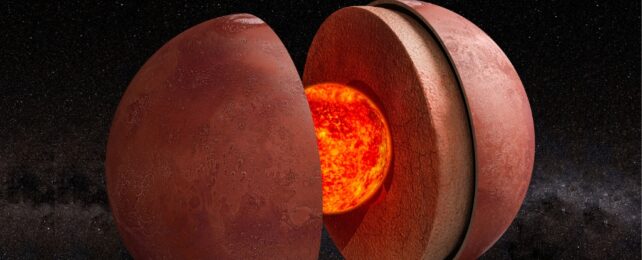 Artistic rendering of the structure of Mars. (alexlmx/Canva)
Artistic rendering of the structure of Mars. (alexlmx/Canva)
Scientists have known for a while that Mars currently lacks a magnetic field, and many blame that for its paltry atmosphere – with no protective shield around the planet, the solar wind was able to strip away much of the gaseous atmosphere over the course of billions of years.
But, evidence has been mounting that Mars once had a magnetic field. Results from Insight, one of the Red Planet's landers, lend credence to that idea, but they also point to a strange feature – the magnetic field seemed to cover only the southern hemisphere, but not the north.
A team from the University of Texas Institute for Geophysics thinks they might know why – in a recent paper, they described how a fully liquid core in Mars could create a lopsided magnetic field like the one seen in Insight's data.
The Earth's core isn't completely molten despite what you may have learned in elementary school. There are two distinct cores – a solid "Inner" core and a molten "Outer" core.
The inner core remains solid due to the immense pressures on the iron and nickel found there. So, the magnetic field that covers our whole planet is, in fact, created only by the Outer Core.
 Simulation of the magnetic fields that were formerly found surrounding Mars. (Ankit Barik/Johns Hopkins University)
Simulation of the magnetic fields that were formerly found surrounding Mars. (Ankit Barik/Johns Hopkins University)Researchers have long thought that a similar dynamic, solid inner and molten outer core, was present on Mars when it maintained a magnetic field billions of years ago.
After about 3.9 billion years, the rocks that formed some of the large impact basins from that time, such as Hellas and Isidis, would contain rocks that would have magnetized while they were cooling due to the presence of the field.
Since they don't, there is little evidence for a strong global magnetic field past that point. The going theory was that, as the planet's core cooled, the entire core became solid, eliminating the spinning molten metal that creates the magnetic field in the first place.
Fraser discusses the question of when Mars' dynamo shut down.
However, there was a strange feature in Mars' magnetic field – a massive difference in strength between the field in the northern and southern hemispheres.
This dichotomy was first noticed during the Mars Global Surveyor mission back in 1997, but data from the Insight lander also confirmed a stark difference between the two hemispheres.
Various explanations have been offered for why the dichotomy existed. These ranged from the effects of large asteroid impacts to very early localized tectonic activity. However, the scientific community has not widely accepted previous explanations.
Enter the new theory from Chi Yan of the University of Texas and their co-authors. Theirs is a two-fold explanation. First, the red planet could have had a wholly molten core, and second, a massive temperature difference between the northern and southern hemispheres led to the heat escaping only in the southern hemisphere.
Magnetic fields can be artificial - as Fraser discusses here.
In Mars' case, a molten core would be a primary mover of the process known as a "planetary dynamo," which creates planetary-scaled magnetic fields. With a solid inner core like the Earth's, the dynamo effect could have been disrupted by inefficiencies in the system's fluid dynamics.
It could also explain how the temperature gradients allow such uneven heat extraction. If the southern hemisphere had much higher thermal conductivity, heat would be more likely to flow through it, causing the churning that creates the planetary dynamo to happen primarily on the southern side of the planet.
To prove their point, the authors created a model version of early Mars using a supercomputer at the Maryland Advanced Research Computing Center. They varied the fluid dynamics of Mars as well as the conductivity of its crust.
They found that the conditions that most accurately matched the results from Insight and Global Surveyor occurred when Mars' core was wholly molten, and there was a significant difference in the thermal conductivity of the northern and southern hemispheres.
Keeping any artificial atmosphere Mars has would require a magnetic field – or something similar.
As with all research, there is plenty more left to do. The authors suggest further analysis of some of the seismic data from Insight to see if any additional data was already collected that could align with the molten core theory.
Other potential paths forward could include improved modeling for a broader range of internal and external planetary conditions or a deeper understanding of Martian meteorites from various regions and times.
For now, this new theory seems to hold water – or molten iron, depending on who you ask. But there is a lot more work that needs to be done to prove this theory and its implications for the existence of life on Mars.
This article was originally published by Universe Today. Read the original article.

.jpg) 4 hours ago
1
4 hours ago
1
 English (US)
English (US)